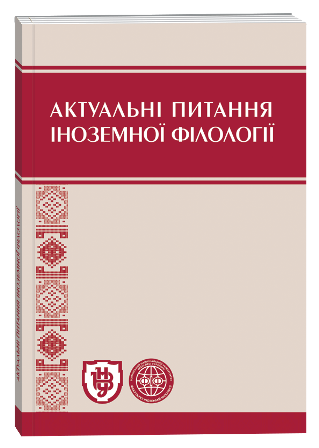FUNCTIONS OF ARCHAISMS IN ENGLISH-LANGUAGE FANTASY TEXTS
Keywords:
fantasy, style, chronotope, archaic words proper, historical words, poetic wordsAbstract
The article is devoted to the description of the main trends in the use of archaic vocabulary in fantasy texts. One of the main features of such texts is the obligatory presence of secondary worlds in which the plot develops, and insofar as such worlds and their realia often do not have references in reality, it is important to study their linguistic aspect, since the correct choice of language means helps the author to create a reliable image of the world, which in turn, contributes to the popularity of works among readers. Fantasy as a multi-genre phenomenon has been drawing the attention of researchers in the fields of philology and other social sciences for decades. In the field of Ukrainian linguistics, texts of this genre are considered mainly from the standpoint of cognitive linguistics and lexicology, but nowadays there is not still enough attention paid to the study of the stylistic aspects of fantasy texts. The purpose of our research is to identify the features of the functioning of archaic vocabulary in popular Englishlanguage fantasy texts from the 1930s to the 2000s. To achieve the goal, we set and fulfilled the following tasks: consideration of archaism as a feature of the chronotope and the lexical system of fantasy; and analysis of the functioning of archaic words proper, historical and poetic words in fantasy texts. The research is based on the texts of R. E. Howard, J. R. R. Tolkien, J. Rowling, T. Goodkind, L. Flewelling and G. R. R. Martin, created between 1932 and 2003. These texts outline the different stages of development of the genre. Analysis of the texts showed that archaic speech is an integral part of the style of fantasy. The authors use the full range of archaic vocabulary to create harmonious secondary worlds, in which hints of the real or legendary past of the real world are clearly traced. Archaic words proper as words or word forms that have fallen out of use, and poetic words as words with heightened stylistic marking function primarily in direct speech of characters, poetic and sacred fragments, providing the text with certain connotations, while historical words, in particular, indicating weapons, clothing and occupations or population strata serve as chronotope markers.
References
Clute, John, and John Grant. 1997. The Encyclopedia of Fantasy. London: Orbit Books.
Halperin, Ilya. 1981. Stylistics. Moscow: Vyshchaya Shkola.
Kukharenko, Valeriya. 2000. Praktykum z stylistyky anhliyskoyi movy. Vinnytsya: Nova Knyha.
Mandala, Susan. 2010. Language in Science Fiction and Fantasy: The Question of Style. London: Continuum International Publishing Group.
Flewelling, Lynn. 1997. Stalking Darkness. New York: Bantam Spectra.
Goodkind, Terry. 2003. Wizard's First Rule. New York: Tor Books.
Howard, Robert E. 2011. Conan the Barbarian. London: Orion Publishing Group.
Martin, George Raymond Richard. 2002. A Clash of Kings. New York: Bantam Books.
Martin, George Raymond Richard. 2000. A Storm of Swords. New York: Bantam Books.
Rowling, J. K. 2003. Harry Potter and the Order of the Phoenix. London: Bloomsbury Publishing.
Tolkien, John Ronald Reuel. 1998. The Fellowship of the Ring. Boston: Mariner Books.
Tolkien, John Ronald Reuel. 2014. The Hobbit: Or There and Back Again. Boston: Mariner Books.
Tolkien, John Ronald Reuel. 1999. The Silmarillion. Boston: Mariner Books.







